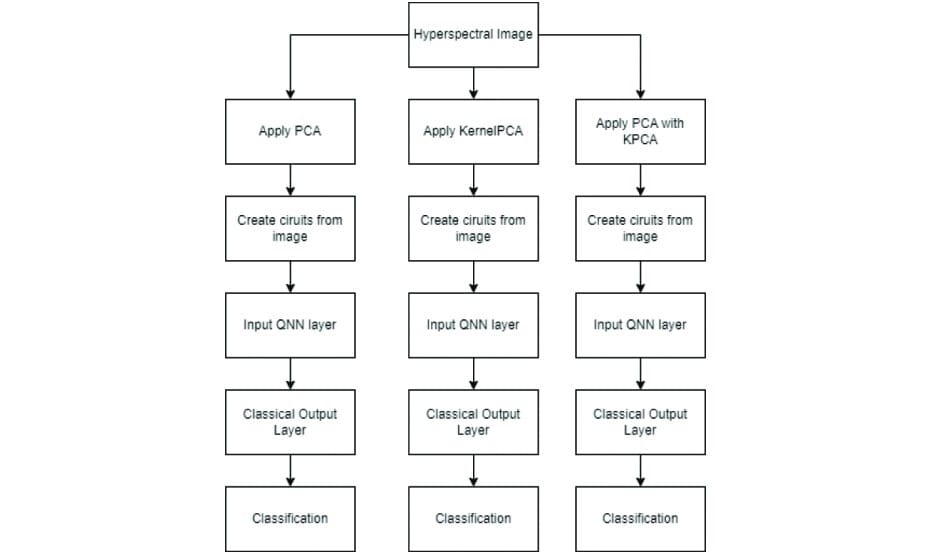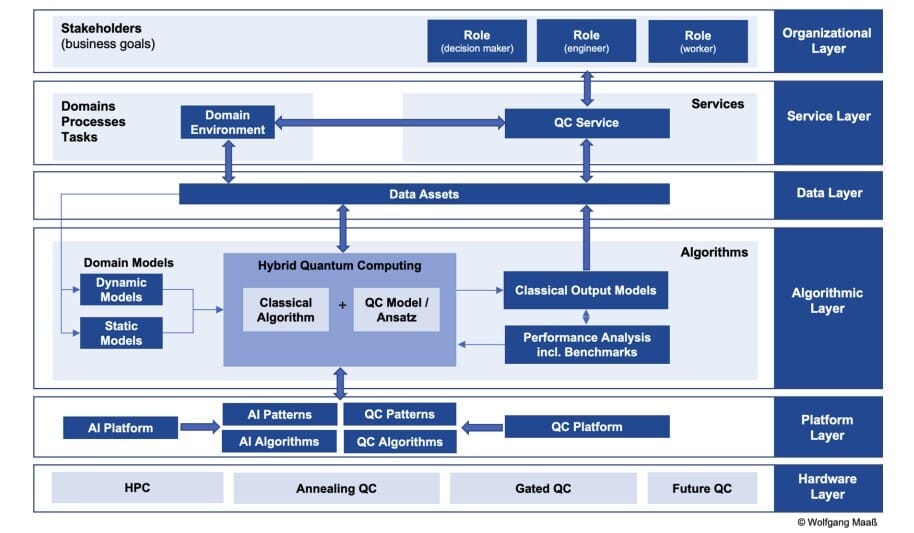- The Daily Qubit
- Posts
- The Daily Qubit
The Daily Qubit
Quantum neural networks for hyperspectral image analysis, a quantum ecosystem to support manufacturing, financial modeling for error correction, quantum sensing takes to the sea, and more.


Friday, November 1st, 2024
Enjoy a nice cup of freshly brewed quantum news ☕️
Today’s issue includes:
Researchers explore the use of quantum neural networks to improve hyperspectral image classification.
A quantum computing-enhanced ecosystem is designed to accelerate and optimize manufacturing simulations.
Plus, financial modeling for error correction, quantum sensing takes to the sea, simulating E&M fields on a quantum computer, and more.

QUICK BYTE: Researchers from the National Institute of Technology Puducherry in Inia explore the use of quantum neural networks to improve hyperspectral image classification.
DETAILS
Hyperspectral images represent a type of imaging data that captures information across a range of wavelengths. Each pixel within a hyperspectral image contains a continuous spectrum of reflected light, effectively creating a “spectral fingerprint.” This is especially useful for distinguishing what may appear similar in conventional images and is highly relevant for fields that require precise material identification, such as tracking water quality or geological surveys.
While capturing continuous spectrums of light is clearly relevant for practical applications, it does create high dimensionality in the data which equates to high computational demand. To reduce this dimensionality while effectively mapping highly complex data, the research team introduces a hybrid quantum neural network model combined with dimensionality reduction techniques like principal component analysis (PCA) and Kernel PCA.
The QNN processes hyperspectral data by encoding reduced spectral features into qubits, which can capture intricate spectral relationships. A parameterized quantum circuit with layers of quantum gates (for example, Hadamard for superposition, Pauli gates for state control, and Ising coupling for entanglement) further supports data pattern recognition and classification capabilities.
The QNN model was benchmarked against a conventional neural network using three common hyperspectral datasets (Indian Pines, Pavia, and Salinas), and achieved consistently higher classification accuracy, especially when paired with hybrid PCA-KPCA.
Increased classification accuracy for hyperspectral imaging has potential applications in environmental monitoring, agriculture, and urban planning. Additionally, this may indicate an advantage of using QML in remote sensing, though further work is needed to address the computational costs of QNNs on classical simulators.
Receive Honest News Today
Join over 4 million Americans who start their day with 1440 – your daily digest for unbiased, fact-centric news. From politics to sports, we cover it all by analyzing over 100 sources. Our concise, 5-minute read lands in your inbox each morning at no cost. Experience news without the noise; let 1440 help you make up your own mind. Sign up now and invite your friends and family to be part of the informed.
QUICK BYTE: The QUASIM project, proposed by scientists from the German Research Center for Artificial Intelligence, Forschungszentrum Jülich, and others introduces a quantum computing-enhanced ecosystem designed to accelerate and optimize manufacturing simulations, focusing on two use cases—milling dynamics and laser cutting.
DETAILS
While explorations of quantum computing to practical applications tend to center around optimization in scheduling, logistics, routing, etc., the authors argue that there is a need to explore how these methods can be applied to manufacturing, specifically in terms of the finite element method (FEM). FEM is a computational technique used to solve complex physical equations, where a material is divided into smaller elements connected at nodes and the interactions between these elements are each represented by numerical equations. These are used to understand how vibrations, stress, and thermal dynamics may effect such processes as milling or laser cutting.
The QUASIM project—QC-Enhanced Service Ecosystem for Simulation in Manufacturing—advocates for the integration of quantum computing into manufacturing simulations as part of an Industry 4.0 framework. The goal of the project is to develop and test algorithms for simulation challenges in manufacturing and visualize an ecosystem with interconnected layers of hardware, algorithms, services, and organizational layers to support.
Two common processes in manufacturing are explicitly explored to further emphasize the problem and solution-fit: milling and laser cutting. For the milling process of compressor blades, FEM is used to simulate milling dynamics to reduce vibrations and improve surface quality. Quantum algorithms, specifically quantum phase estimation, provide faster eigenvalue problem solutions, a core aspect of these simulations, promising more efficient and accurate process optimizations.
In the laser cutting of metals, quantum machine learning models, such as parameterized quantum circuits, can be used to predict heat dispersion and thermal expansion during cutting. This addresses the thermal buildup that often leads to production delays, using quantum-enhanced graph neural networks to improve simulation accuracy and reduce computational requirements.
By embedding quantum computing into manufacturing simulations, QUASIM hopes to address industrial challenges with scalable, high-precision solutions that can adapt to diverse use cases. Future goals include developing user-friendly, industry-ready software prototypes that can demonstrate quantum’s potential in manufacturing for broader adoption and long-term competitive advantages.

IBM Quantum and Los Alamos National Laboratory introduced Conditional Value at Risk to manage noise in quantum systems, focusing on worst-case outcomes to provide accurate noise-free bounds. Unlike traditional error mitigation methods, CVaR reduces sampling overhead and provides scalable noise management for fidelity estimation and quantum optimization tasks. It was demonstrated on IBM’s 127-qubit system and offers practical improvements for machine learning and optimization algorithms.
Aquark Technologies, in partnership with the Royal Navy, demonstrated its cold atom technology on the sea aboard the HMS Pursuer, highlighting its potential as a precise, GPS-independent position, navigation, and timing solution. Using a laser-cooling method that eliminates the need for magnetic fields, the system is compact, energy-efficient, and suitable for military applications. With €5 million (approximately $5.44 million) in seed funding from NATO and other defense investors, Aquark is comitted to advancing quantum sensing as an alternative PNT technology.
QunaSys has partnered with Hon Hai Research Institute to integrate Hon Hai’s fermionic encoding techniques in order to enhance quantum simulations within QunaSys' QURI Parts toolkit. The collaboration will focus on using AI to improve these encoding methods, making simulations of complex quantum systems more efficient and accurate for both quantum simulators and real quantum computers.
MIT researchers have developed a technique to create synthetic electromagnetic fields on their 16-qubit superconducting quantum processor, enabling them to emulate electron behaviors in materials under electromagnetic influence. By dynamically controlling the couplings among the 16 qubits, the team replicated complex electron hopping behaviors seen in magnetic fields. This allows for precise simulations of material properties, such as conductivity and phase transitions, opening pathways for quantum computers to study condensed matter phenomena with adjustable electromagnetic settings.
The new quantum workforce roadmap from CU Boulder’s CUbit Quantum Initiative and partners outlines strategies to train a diverse and inclusive quantum workforce for Colorado and the Mountain West. Key initiatives include integrating quantum topics into K-12 education, expanding community college programs in relevant fields, and fostering pathways for underrepresented groups. Backed by Elevate Quantum and $120 million in funding, this roadmap will support the region’s growing quantum industry, projected to increase employment from 3,000 to 10,000 in the next decade.
Quantum Motion, collaborating with Goldman Sachs, has developed a method to optimize quantum computing for complex financial calculations, such as options pricing. They leverage parallel, small-task execution to enhance runtime, enabling efficient multi-qubit operations within constrained qubit systems. The research also explores applications in chemistry and materials science, using quantum algorithms to approximate Coulomb potentials and improve predictive modeling for quantum hardware.

In this podcast, host Konstantinos Karagiannis interviews Microsoft Quantum software engineer Mariia Mykhailova, discussing her books designed to bridge the gap between learning quantum programming and tackling real-world quantum coding challenges.

How many qubits was today's newsletter? |






